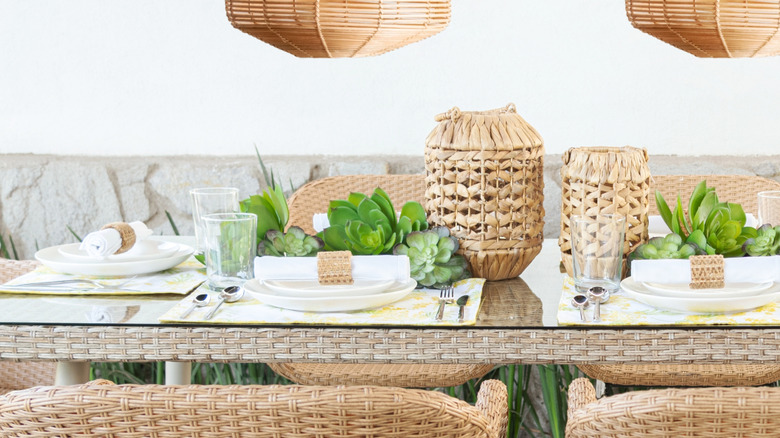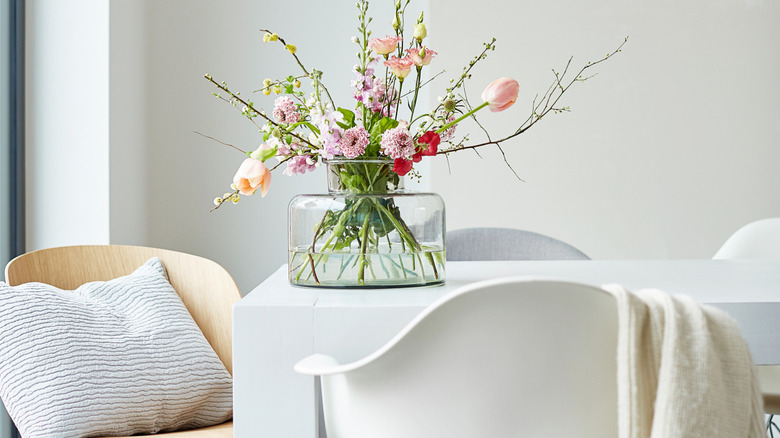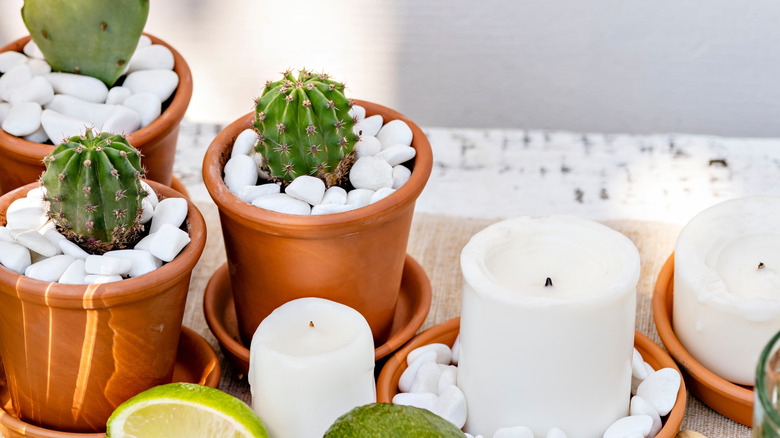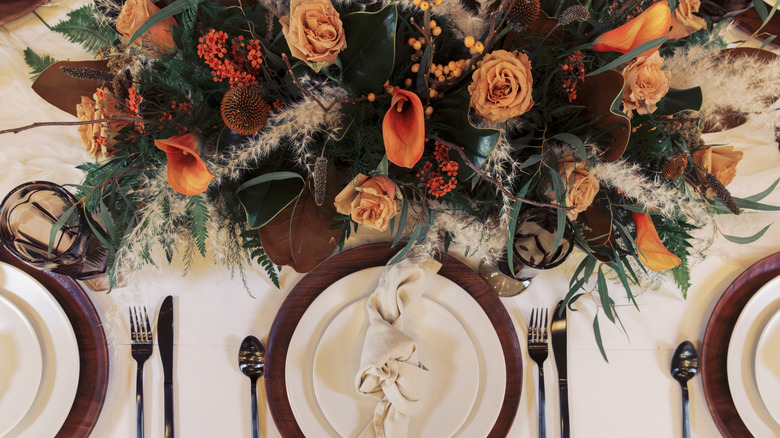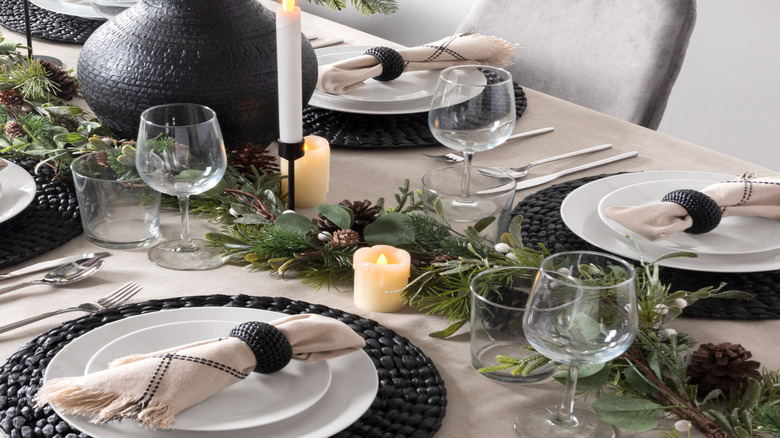How To Create The Perfect All-Natural Centerpiece For Each Season
While some people love changing up their decor for every holiday, there are many others that find this frequency too time-consuming, cost prohibitive, or that it simply produces too much stuff to deal with and store. Therefore, the best approach for avoiding decor fatigue is to create timeless, long-lasting statements that will work for an entire season. The key to do this successfully is to avoid holiday-related specific decor and look to nature to create elegant, organic displays, such as table centerpieces, that mirror the season and stay relevant for months. If you choose to add in small holiday-specific touches from there, it will ensure you do not have to rework the entire centerpiece each month.
When it comes to florals and greenery, you have a few options based on your preferences. Real-looking artificial flowers and sprays can be reused year after year with no maintenance, though the initial investment can be higher for quality picks and you have to store them when not in use. Conversely, you can use all-fresh seasonal flowers or greenery to create your arrangements. However, this means purchasing and arranging new flowers every few weeks, so while it may be ideal for those who adore fresh flowers, it doesn't exactly reduce effort on the decor front.
Lastly, you could easily mix artificial stems with a few fresh flowers from the garden, meaning the effort to switch out only a portion would be less than for a whole arrangement. No matter if you prefer faux stems or fresh blooms, use nature as your inspiration for chic dining room table centerpieces so you can spend less time decorating and more time enjoying the ambiance.
Flowering branches, ephemeral blooms, and soft hues for spring
Spring is all about that fresh, airy feeling as you emerge from winter into the start of a lighthearted season full of new growth, pops of soft color, and possibility. Early spring brings a very distinctive set of early bloomers, called spring ephemerals, such as tulips, daffodils, crocuses, and hyacinth. It also introduces small blossoms on the branches of your favorite trees.
When choosing stems for your spring arrangements, create a sprawling, airy design with amazing flowering branches like cherry blossoms, quince, apple blossoms, flowering dogwood, and forsythia. Then add in with your favorite spring ephemerals, as well as blooms in pastel hues such as lilac, lavender, garden roses, carnations, ranunculus, snapdragons, baby's breath, and andromeda for a soothing, organic feeling. Fill in the gaps with a base of greens such as Italian ruscus, asparagus fern, and bells of Ireland for a more lush yet still soft and light aesthetic.
Use white vessels for airy, fresh vibes, or clear vases with the water visible to bring images of rain and dew drops to mind. A grouping of small bud vases or a mini propagation station with flowers is adorable in spring centerpieces, as the small groupings of flowers feel like the first few flowers emerging and beginning to grow in the first part of the season. From there, if you would like to introduce holiday-specific fillers for celebrations like Easter, choose nature-inspired add-ins like wood bunny figurines, small nests with decorative birds eggs, or and moss accents.
Vibrant colors and lush greens for summer
Summer centerpieces should evoke the same free-spirited, fun, colorful vibes that the season brings. With nature in full bloom with endless color, summer feels abundant and joyfully untethered — and so should your centerpiece. Use flowers with vivid, warm hues that epitomize summer, such as zinnias, hydrangeas, peonies, sunflowers, lilies, orchids, bright dahlias, birds of paradise, daisies, celosia, poppies, or wildflowers. Succulents and cacti are also wonderful additions to the warm vibes of the season. Use lush, bold greenery like Boston ferns, maidenhair ferns, bay leaves, or Israeli ruscus, or lean into a tropical vibe with palm leaves and monstera. Fill in planters with vibrant moss for another layer of color.
For a summer desert vibe, use warm sunset colors and cacti, whereas if you want to go for a vibrant, playful vacation feeling, use a variety of bright tones with citrus fruit in bowls or nestled into the centerpiece (artificial will last longer but fresh is edible!). For a moodier summer evening look, opt for deep pinks and purples with fresh greenery to give that after-dark aesthetic. Finally, if you are more into neutrals, go wild with an assortment of greens, whether in an arrangement, a flowing garland, or a collection of potted plants.
Have fun with your vases and vessels, using brightly colored glass or ceramic vases, terracotta pots, or black bowls to really make the vivid hues pop. Use herbs or succulents to emphasize the growing and abundance aspects of summer. Alternatively, curate a collection of glass terrariums for the centerpiece that feel varied and interesting. Floral arrangements should be overflowing, sculptural, or wild to fit with the free-spirited summer vibes.
Warm tones and dried grasses for fall
Fall is known for its warm hues and distinct change in mood from the vacation-mode of summer months. The heat dies down to make way for cooler temperatures and cozy vibes. Once vibrant grasses turn amber, while green leaves become an autumn blaze of color. There are several holidays in fall, but creating a universal nature-based centerpiece for the season will cover them all.
Begin fall centerpieces with autumn berry branches, such as American bittersweet or persimmon, and uniquely shaped dried grasses to create dynamic shapes and endless texture, such as yucca, pampas grass plumes, sun palm, wheat, or millet. You can stop there, making your entire centerpiece a dried masterpiece full of warm earth tones, or add flowers for color in red, orange, yellow, and dark purple hues, such as mums, spider mums, dahlias, amaranth, protea, chrysanthemums, deep-purple artichokes, and flowering cabbage. Add a bit of whimsy to any arrangement with unique shapes like button flowers, hare's tail grasses, and yellow gem grass. Use neutral, warm, or faded green fillers like broom corn, purple eucalyptus, or silver dollar eucalyptus to finish the look.
Choose brown or amber glass, gold, and copper vessels to emphasize the warm fall aesthetic. Add in sprays of artificial feathers for some texture and pattern, or opt for some seasonal fruit like cranberries, pomegranates, or dried oranges for more of a harvest vibe. Finally, since fall is all about feeling hygge and entertaining loved ones, candles (real or battery-operated) are a must for an autumn centerpiece. For Halloween and Thanksgiving, layer in some small pumpkins, gourds, squash, or other holiday decor as desired.
Evergreen sprigs, white florals, and frosted berries for winter
When you think of decorating for the winter months, you likely jump straight to Christmas or Hanukkah. But the reality is that after December ends, there are (at least) two more months of winter. So make your natural centerpiece celebrate the entire winter season, while adding in special touches for December's festivities.
Winter is all about the hearty evergreen trees that peek out from under the white snow, so for the perfect foundation, create a base of garlands or sprigs of pine, fir, flat cedar, juniper, or rosemary. Fill in with more vibrant greens such as magnolia, holly, and eucalyptus to add flowy softness into the more rigid evergreens. Add in feathery Queen Anne's lace or white dusty miller to pop against the green and make the arrangement look dusted in snow, and use white flowers such as roses and calcynia for additional beauty. Finally, layer in texture with pinecones and neutral or frosted-looking berries, such as juniper, gold winterberry holly, and pip berries.
Use natural wood or textured white/gray vessels, such as plaster or lacy etched finishes, to add to the outdoor, snowy vibe. Alternatively, opt for silver, champagne, or gold options to add sparkle. Candles or fairy lights will add a warm, cozy twinkle to the days that get dark so early. For Christmas, add in red berries, poinsettias, or roses, or consider introducing blue stems of viburnum berries, delphinium, thistle, or hydrangea for celebrating the Festival of Lights. Coordinating ribbon, ornaments, baubles, and other decor can be added for December, and then you can pare it back to home decor that can beat the winter blues.
